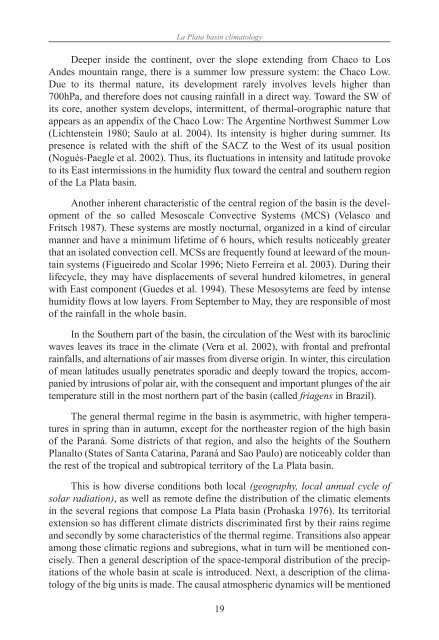chapter - Atmospheric and Oceanic Science
chapter - Atmospheric and Oceanic Science
chapter - Atmospheric and Oceanic Science
You also want an ePaper? Increase the reach of your titles
YUMPU automatically turns print PDFs into web optimized ePapers that Google loves.
La Plata basin climatology<br />
Deeper inside the continent, over the slope extending from Chaco to Los<br />
Andes mountain range, there is a summer low pressure system: the Chaco Low.<br />
Due to its thermal nature, its development rarely involves levels higher than<br />
700hPa, <strong>and</strong> therefore does not causing rainfall in a direct way. Toward the SW of<br />
its core, another system develops, intermittent, of thermal-orographic nature that<br />
appears as an appendix of the Chaco Low: The Argentine Northwest Summer Low<br />
(Lichtenstein 1980; Saulo at al. 2004). Its intensity is higher during summer. Its<br />
presence is related with the shift of the SACZ to the West of its usual position<br />
(Nogués-Paegle et al. 2002). Thus, its fluctuations in intensity <strong>and</strong> latitude provoke<br />
to its East intermissions in the humidity flux toward the central <strong>and</strong> southern region<br />
of the La Plata basin.<br />
Another inherent characteristic of the central region of the basin is the development<br />
of the so called Mesoscale Convective Systems (MCS) (Velasco <strong>and</strong><br />
Fritsch 1987). These systems are mostly nocturnal, organized in a kind of circular<br />
manner <strong>and</strong> have a minimum lifetime of 6 hours, which results noticeably greater<br />
that an isolated convection cell. MCSs are frequently found at leeward of the mountain<br />
systems (Figueiredo <strong>and</strong> Scolar 1996; Nieto Ferreira et al. 2003). During their<br />
lifecycle, they may have displacements of several hundred kilometres, in general<br />
with East component (Guedes et al. 1994). These Mesosytems are feed by intense<br />
humidity flows at low layers. From September to May, they are responsible of most<br />
of the rainfall in the whole basin.<br />
In the Southern part of the basin, the circulation of the West with its baroclinic<br />
waves leaves its trace in the climate (Vera et al. 2002), with frontal <strong>and</strong> prefrontal<br />
rainfalls, <strong>and</strong> alternations of air masses from diverse origin. In winter, this circulation<br />
of mean latitudes usually penetrates sporadic <strong>and</strong> deeply toward the tropics, accompanied<br />
by intrusions of polar air, with the consequent <strong>and</strong> important plunges of the air<br />
temperature still in the most northern part of the basin (called friagens in Brazil).<br />
The general thermal regime in the basin is asymmetric, with higher temperatures<br />
in spring than in autumn, except for the northeaster region of the high basin<br />
of the Paraná. Some districts of that region, <strong>and</strong> also the heights of the Southern<br />
Planalto (States of Santa Catarina, Paraná <strong>and</strong> Sao Paulo) are noticeably colder than<br />
the rest of the tropical <strong>and</strong> subtropical territory of the La Plata basin.<br />
This is how diverse conditions both local (geography, local annual cycle of<br />
solar radiation), as well as remote define the distribution of the climatic elements<br />
in the several regions that compose La Plata basin (Prohaska 1976). Its territorial<br />
extension so has different climate districts discriminated first by their rains regime<br />
<strong>and</strong> secondly by some characteristics of the thermal regime. Transitions also appear<br />
among those climatic regions <strong>and</strong> subregions, what in turn will be mentioned concisely.<br />
Then a general description of the space-temporal distribution of the precipitations<br />
of the whole basin at scale is introduced. Next, a description of the climatology<br />
of the big units is made. The causal atmospheric dynamics will be mentioned<br />
19






